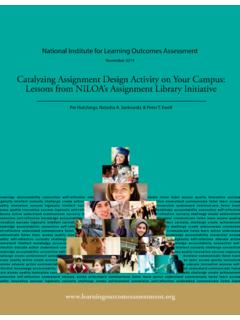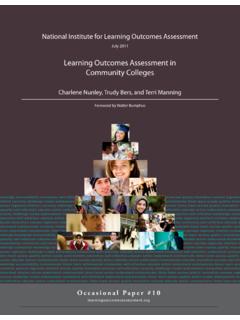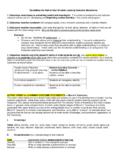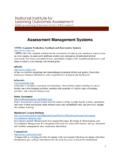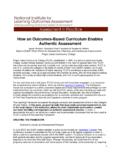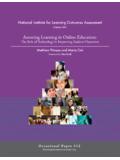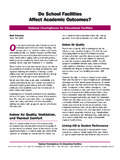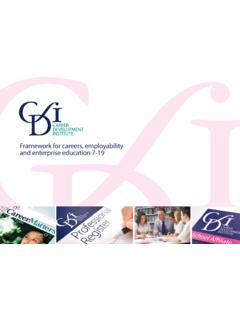Transcription of Aligning Educational Outcomes and Practices
1 national institute for learning Outcomes Assessment | 1 knowledge accountability connection self-reflection educate action understand communicate listen learn access quality innovation success ingenuity intellect curiosity challenge create achievement connection self-reflection educate action understand communicate listen learn access quality innovation success ingenuity intellect curiosity challenge knowledge accountability connection understand communicate listen learn access quality innovation success ingenuity self-reflection educate action understand intellect knowledge accountability connection self-reflection educate action understand communicate curiosity challenge create achievement connection self-reflection curiosity challenge create achievement connection self-reflection knowledge accountability connection self-reflection educate action understand communicate listen learn access quality innovation success ingenuity intellect curiosity challenge educate innovation success ingenuity intellect curiosity challenge create achievement knowledge accountability connection self-reflection educate action understand communicate curiosity challenge create achievement connection self-reflection understand communicate listen learn access quality action educate action understand communicate listen learn action understand communicate listen learn access quality innovation success ingenuity intellect curiosity challenge knowledge
2 Accountability connection access quality self-reflection curiosity challenge create achievement learn access quality innovation success ingenuity self-reflection educate action understand intellect knowledge accountability connection self-reflection educate action understand knowledge accountability connection self-reflection educate action understand communicate listen learn access quality innovation success ingenuity intellect curiosity challenge connection knowledge accountability connection self-reflection educate action understand communicate listen learn access quality innovation success ingenuity challenge create achievement connection self-reflection educate action understand connection self-reflection understand communicate listen learn access quality action create achievement connection self-reflection educate action understand communicate listen learn access quality innovation success educate action communicate listen learn access quality action educate action understand communicate educate innovation success self-reflection knowledge accountability communicate listen learn achievement connection self-reflection educate action understand communicate listen learn access quality innovation success ingenuity intellect access quality innovation success self-reflection curiosity challenge create achievement connection self-reflection understand educate action understand communicate listen learn action understand communicate listen learn access quality innovation success ingenuity curiosity challenge
3 Create achievement connection self-reflection understand communicate listen learn Aligning Educational Outcomes and PracticesPat HutchingsNational institute for learning Outcomes AssessmentJanuary 2016 Occasional Paper # institute for learning Outcomes Assessment | 2 NILOA Mission The national institute for learning Outcomes Assessment s (NILOA) primary objective is to discover and disseminate the ways that academic programs and institutions can productively use assessment data internally to inform and strengthen undergraduate education, and externally to communicate with policy makers, families, and other stakeholders. Educational Outcomes and Practices ..4 Alignment through Curricular The Faculty Eye Meeting in the Students Making national Advisory of ContentsNational institute for learning Outcomes Assessment | 3 Abstract The notion of alignment has become increasingly prominent in efforts to improve student learning today.
4 The term, as used in this paper, refers to the linking of intended student learning Outcomes with the processes and Practices needed to foster those Outcomes . Alignment is not a new idea, but it has become more salient as increasing numbers of campuses have devised institution-level learning Outcomes , and as frameworks such as the Association of American Colleges and Universities (AAC&U) Essential learning Outcomes (ELOs), Lumina Foundation s Degree Qualifications Profile (DQP), and Tuning USA have become widely known and adopted. It has also become more important as students swirl through multiple institutions, stop out and return, and take advantage of the growing set of providers offering courses, badges, and certificates. Seen from this perspective, alignment is a much-needed counter to fragmentation and incoherence.
5 But achieving alignment isn t easy. In 2013 only four in ten institutions reported that the learning goals of all of their academic programs were aligned with the institution s stated learning Outcomes . Drawing on work by the national institute for learning Outcomes Assessment (NILOA), this paper explores what campuses can do to facilitate this process in a way that makes a difference in the experience and achievements of learners. Specifically it reviews the use of curricular mapping as one prominent approach to achieving alignment; explores another approach that emerges more directly from the interests and work of faculty; proposes a number of implications for approaching the work of alignment; and concludes with an examination of the roles that students can play in our thinking about alignment.
6 The aim of the paper is to begin to crack open this topic in ways that recognize its multiple levels, full range of contributors, and complexity. national institute for learning Outcomes Assessment | 4 Aligning Educational Outcomes and PracticesPat HutchingsIntroduction In 2009, members of the history department at Utah State University (USU) began a conversation that would lead them on an unexpected but consequential journey that continues today. The context of that conversation was Tuning USA, a national initiative modeled on Europe s Bologna process, designed to identify points of reference, convergence, and common understanding about student learning Outcomes in different areas of study (quoted by McInerney, 2015, p. 31). Faculty were deeply skeptical at first, troubled that the project turned attention away from a pressing budgetary crisis raised by the Great Recession, worried that the process might lead to unwanted scrutiny of their program s effectiveness, and concerned that Tuning would require a time-consuming effort yielding few meaningful returns.
7 But over time, concerns about how the process might go wrong helped shape it in positive ways ways that were not about external reporting and accountability but about faculty s real interest in improving the character and quality of their students understanding of the discipline. The result was a gradually emergent and increasingly robust conversation about what history students should know and be able to do. Particularly powerful in shaping that conversation was the realization that many department faculty were dissatisfied with student performance in the program s capstone course, which required an original contribution to research in the field. But why, exactly, was that so difficult, colleagues asked one another? What were students doing or not doing in earlier courses that would prepare them for such work?
8 What did they need to do in order to be better prepared? Over time, the result of these deliberations was a significant rethinking and reshaping of the program, starting with the introductory course, rippling through other courses along the way, and leading eventually to a new pre-major model (also adopted by other USU departments) that linked program goals with broader general education offerings and Outcomes . Today USU history students move through an intentional sequence of courses in which they encounter assignments designed to foster and document the Outcomes that define achievement in the discipline and in broader areas of liberal learning . Meanwhile, seeking to understand the impact and effectiveness of the new model, faculty have explored a variety of instruments and approaches designed to document the learning students achieve including rubrics employed at several levels, course evaluations that ask students to engage in self-assessment, more meaningful exit surveys, and assignments more Meaningful alignment is possible.
9 Today Utah State University history students move through an intentional sequence of courses in which they encounter assignments designed to foster and document the Outcomes that define achievement in the discipline and in broader areas of liberal institute for learning Outcomes Assessment | 5 closely tied to learning Outcomes . Evidence gathered in these ways can help to affirm the value of changes that are now in place and may also point the way to further refinements in the future. This story, as recounted by USU history professor Daniel McInerney (2015), is a powerful illustration of what can be accomplished when a program seriously engages in the Tuning process. It is a reminder, too, of the twists and turns of pedagogical and curricular reform; change requires patience and tenacity; it moves slowly and takes small steps.
10 Additionally, and for the purposes of this paper, the experience recounted by McInerney is a window on the notion of alignment that has become increasingly prominent in serious efforts to improve student learning today. Context Alignment, as used in this paper, refers to the linking of intended student learning Outcomes with the processes and Practices needed to foster those Outcomes . In the case of the USU history department, these include curriculum and course design, the assignments students are required to complete, and the instructional approaches employed by faculty. But alignment is also about connecting Outcomes more clearly to the character of co-curricular opportunities, and to the policies that govern transfer and other aspects of students movement through the higher education is not a new idea, but it has become more salient as increasing numbers of campuses 84 percent as of 2013 have devised institution-level learning Outcomes (Kuh, Jankowski, Ikenberry, & Kinsey, 2014), and as frameworks such as the Association of American Colleges and Universities (AAC&U) Essential learning Outcomes (ELOs), Lumina Foundation s Degree Qualifications Profile (DQP), and Tuning USA have become widely known and adopted.

